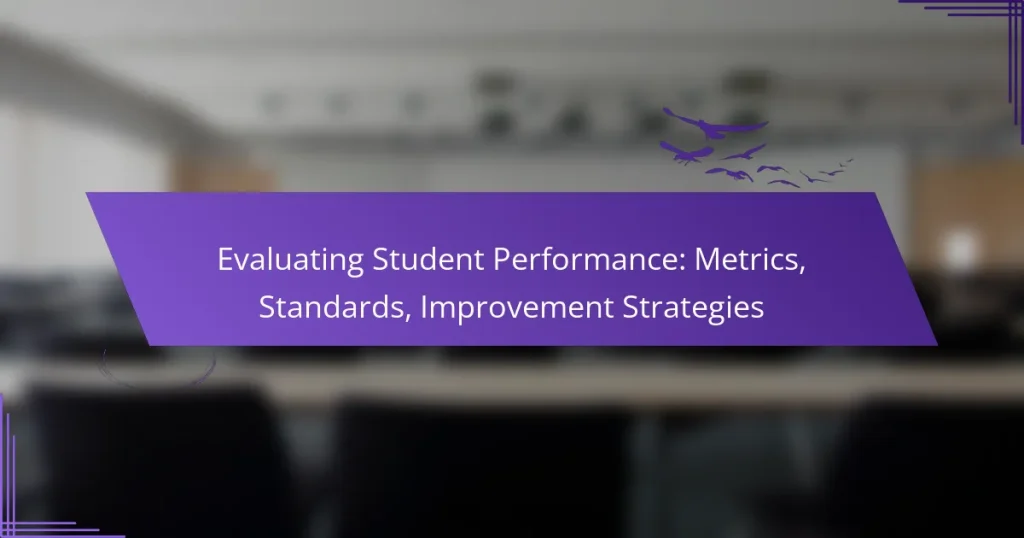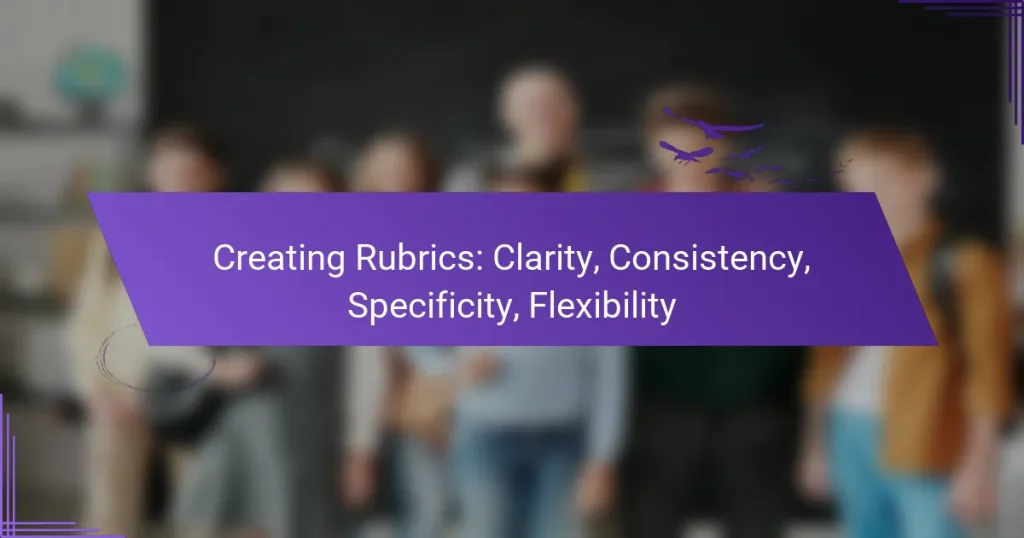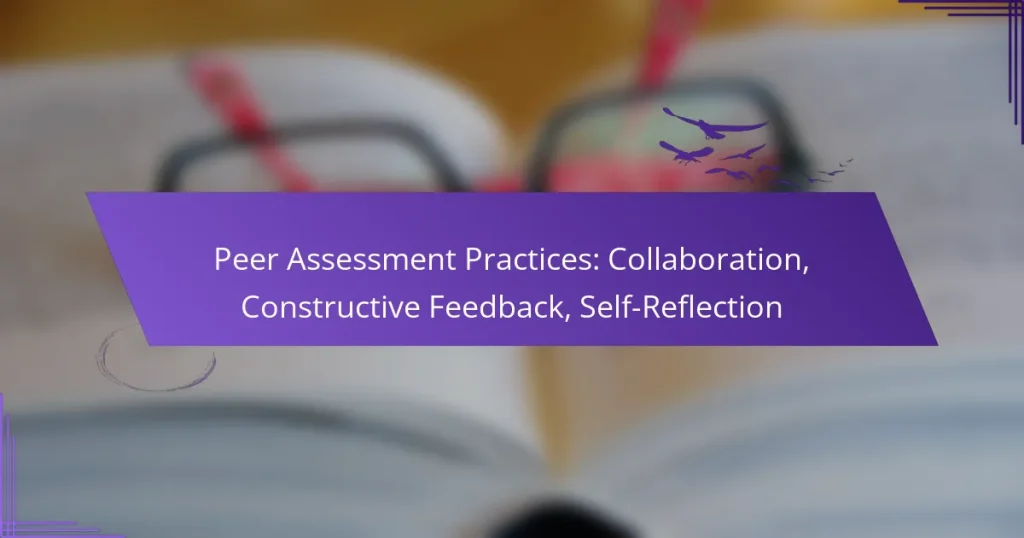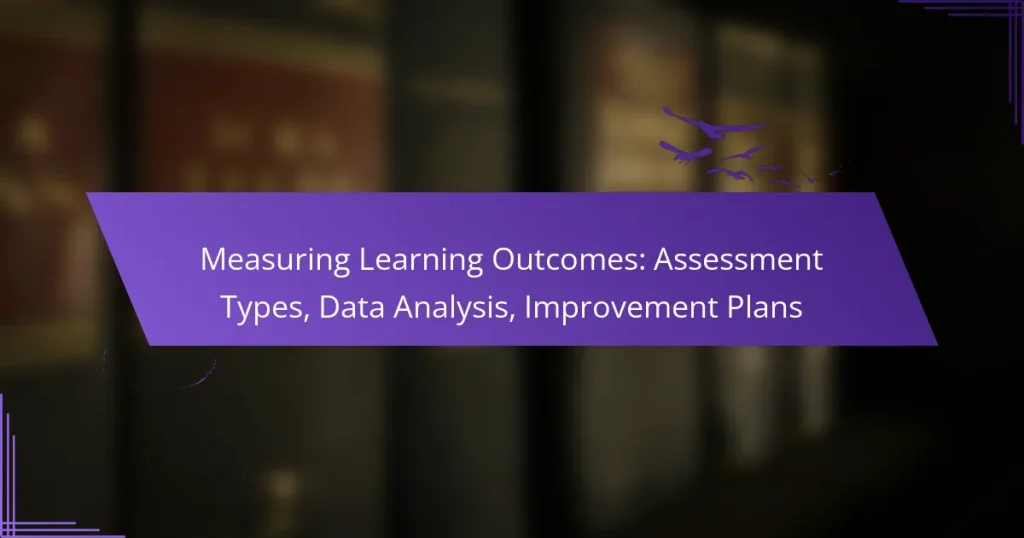Interactive classroom materials play a crucial role in assessment methods, offering various approaches such as formative, summative, peer, self, and project-based assessments. By leveraging technology, educators can enhance these assessments, providing real-time feedback and fostering personalized learning experiences that cater to diverse student needs.
Innovative Assessment Techniques: Engagement, Feedback, Adaptability, Collaboration
Tools for Real-Time Assessments: Technology Integration, User Experience, Data Collection
Formative Assessment Strategies: Real-Time Feedback, Student Involvement, Learning Goals
Creating Rubrics: Clarity, Consistency, Specificity, Flexibility
Peer Assessment Practices: Collaboration, Constructive Feedback, Self-Reflection
Measuring Learning Outcomes: Assessment Types, Data Analysis, Improvement Plans
What are effective assessment methods for interactive classroom materials?
Effective assessment methods for interactive classroom materials include formative, summative, peer, self, and project-based assessments. Each method serves a unique purpose in evaluating student understanding and engagement with the materials.
Formative assessments
Formative assessments are ongoing evaluations that occur during the learning process. They provide immediate feedback to both students and educators, allowing for adjustments in teaching strategies and learning activities. Examples include quizzes, polls, and interactive discussions that gauge comprehension in real-time.
To implement formative assessments effectively, consider using technology tools that facilitate instant responses, such as clickers or online platforms. Aim for frequent, low-stakes assessments to keep students engaged and informed about their progress.
Summative assessments
Summative assessments evaluate student learning at the end of an instructional unit by comparing it against a standard or benchmark. These assessments typically include final exams, projects, or standardized tests. They are designed to measure the cumulative knowledge and skills acquired over a specific period.
When designing summative assessments, ensure they align with the learning objectives and cover a representative sample of the material. Using a mix of question types—such as multiple-choice, essays, and practical applications—can provide a comprehensive evaluation of student understanding.
Peer assessments
Peer assessments involve students evaluating each other’s work, fostering collaboration and critical thinking. This method encourages students to engage with the material more deeply and develop their evaluative skills. Peer feedback can be structured through rubrics or guided questions to ensure constructive criticism.
To implement peer assessments effectively, establish clear criteria and provide training on giving and receiving feedback. This practice not only enhances learning but also builds a sense of community in the classroom.
Self-assessments
Self-assessments empower students to reflect on their own learning and identify areas for improvement. By evaluating their performance against set criteria, students develop metacognitive skills and take ownership of their educational journey. Tools like journals, checklists, or reflective essays can facilitate this process.
Encourage regular self-assessment by integrating it into the learning routine. Provide students with guidance on how to assess their work honestly and constructively, which can lead to greater self-awareness and motivation.
Project-based assessments
Project-based assessments require students to apply their knowledge and skills to complete a project, often involving real-world problems. This method promotes critical thinking, creativity, and collaboration, as students work together to produce tangible outcomes. Examples include research projects, presentations, or community service initiatives.
When planning project-based assessments, define clear objectives and expectations. Allow for flexibility in how students demonstrate their learning, and incorporate opportunities for feedback throughout the project to enhance the learning experience.
How can technology enhance assessment methods?
Technology can significantly enhance assessment methods by providing real-time feedback, increasing engagement, and allowing for personalized learning experiences. By integrating digital tools, educators can create more interactive and effective assessments that cater to diverse learning styles.
Online quizzes and polls
Online quizzes and polls are effective tools for assessing student understanding in a dynamic way. They can be created using various platforms that allow for immediate feedback, which helps students identify areas needing improvement. Consider using tools like Kahoot or Google Forms, which are user-friendly and can be tailored to different subjects.
When designing online quizzes, aim for a mix of question types, such as multiple-choice, true/false, and short answer. This variety keeps students engaged and provides a more comprehensive assessment of their knowledge.
Learning management systems
Learning management systems (LMS) streamline the assessment process by centralizing resources, tracking student progress, and facilitating communication. Platforms like Moodle or Canvas allow educators to create assessments that can be easily administered and graded, saving time and effort.
Utilize the analytics features of an LMS to gain insights into student performance and engagement. This data can inform instructional strategies and help identify students who may need additional support.
Interactive simulations
Interactive simulations offer a hands-on approach to assessment, allowing students to apply their knowledge in realistic scenarios. These tools can be particularly beneficial in fields such as science and engineering, where practical application is crucial for understanding concepts.
When implementing simulations, ensure they align with learning objectives and provide clear instructions. Platforms like PhET or Labster can be excellent resources for creating immersive learning experiences that assess student skills effectively.
What are the benefits of using interactive materials in assessments?
Interactive materials enhance assessments by making them more engaging, providing immediate feedback, and allowing for personalized learning experiences. These benefits lead to improved student performance and a deeper understanding of the material.
Increased engagement
Using interactive materials in assessments significantly boosts student engagement. When learners interact with content—through quizzes, simulations, or gamified elements—they are more likely to stay focused and motivated. This active participation can lead to better retention of information.
For example, incorporating interactive quizzes that allow students to answer questions in real-time can create a dynamic classroom atmosphere. Engaged students are more likely to contribute to discussions and collaborate with peers, enhancing the overall learning experience.
Immediate feedback
Interactive assessments provide immediate feedback, which is crucial for effective learning. Students can quickly see their results, understand their mistakes, and make adjustments to their learning strategies. This timely information helps them grasp concepts more thoroughly and reduces the anxiety associated with waiting for grades.
For instance, online platforms often offer instant scoring and explanations for incorrect answers, allowing students to learn from their errors right away. This immediate response can significantly enhance their understanding and retention of the material.
Personalized learning experiences
Interactive materials facilitate personalized learning experiences by adapting to individual student needs. Assessments can be tailored to match a student’s skill level, allowing for a customized approach that addresses specific learning gaps. This personalization can lead to more effective learning outcomes.
Teachers can use data from interactive assessments to identify areas where students struggle and adjust their teaching methods accordingly. For example, if a group of students consistently performs poorly on a particular topic, the teacher can provide additional resources or targeted instruction to help them improve.
What criteria should educators consider when selecting assessment methods?
Educators should consider alignment with learning objectives, accessibility for all students, and scalability of assessments when selecting assessment methods. These criteria ensure that assessments are effective, inclusive, and manageable within the classroom environment.
Alignment with learning objectives
Assessment methods must directly reflect the learning objectives set for the course or lesson. This alignment ensures that the assessments measure what students are expected to learn and achieve. For example, if a learning objective focuses on critical thinking, assessments should require students to analyze and evaluate information rather than just recall facts.
To maintain alignment, educators can use backward design, starting with the desired outcomes and then developing assessments that accurately gauge student progress toward those goals. Regularly reviewing and adjusting assessments based on student performance can also help maintain this alignment.
Accessibility for all students
Accessibility is crucial in assessment methods to ensure that all students, including those with disabilities, can participate fully. This may involve providing alternative formats, such as oral assessments or extended time for completion. Educators should be familiar with accessibility standards and guidelines, such as the Americans with Disabilities Act (ADA) in the U.S., to create equitable assessment opportunities.
Additionally, incorporating universal design principles can enhance accessibility. For instance, using clear language, varied question formats, and multiple means of representation can help accommodate diverse learning needs and preferences.
Scalability of assessments
Scalability refers to the ability to effectively administer assessments to a larger group of students without compromising quality. Educators should consider whether their chosen assessment methods can be efficiently scaled up or down based on class size or resource availability. For example, online assessments can often be scaled more easily than traditional paper-based tests.
When planning assessments, educators should evaluate the time and resources required for grading and feedback. Utilizing automated grading tools or peer assessments can help manage larger groups while maintaining meaningful evaluation processes. Regularly revisiting and refining assessment strategies can also support scalability as class dynamics change.
What are common challenges in implementing interactive assessments?
Common challenges in implementing interactive assessments include technical difficulties, time constraints, and resistance to change. Each of these factors can hinder the effective integration of interactive methods into educational settings.
Technical difficulties
Technical difficulties often arise from inadequate infrastructure or lack of familiarity with the tools. Schools may face issues such as unreliable internet connections or insufficient hardware, which can disrupt the assessment process.
To mitigate these challenges, institutions should invest in reliable technology and provide training for educators. Regular maintenance and updates of software can also help ensure smooth operation during assessments.
Time constraints
Time constraints can limit the ability of educators to design and implement interactive assessments effectively. Preparing engaging materials and ensuring that all students are adequately trained to use the technology can be time-consuming.
To address this, educators can utilize pre-made templates or resources that streamline the assessment creation process. Setting aside dedicated time for training students can also enhance their readiness and reduce delays during assessments.
Resistance to change
Resistance to change is a common barrier when introducing new assessment methods. Educators and administrators may prefer traditional assessment formats due to familiarity and perceived reliability.
To overcome this resistance, it is crucial to communicate the benefits of interactive assessments, such as increased student engagement and improved learning outcomes. Providing opportunities for educators to experience these methods firsthand can also help ease their concerns.






